Updated: 31-Jul-2019
Ford Motor Co. in Detroit, MI, has been involved in aviation issues on numerous occasions. In 1918 they manufactured a Liberty 12 A model that gave 400 hp. One of these engines can be seen at the NASM museum.
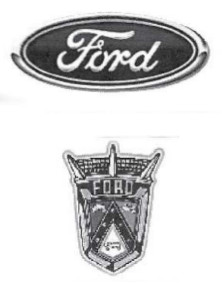
“Ford logos”

"Liberty-Ford, 400 hp, V12"
-In total, and between Ford, Lincoln, Packard, Marmon and Buick about 20,748 engines of this type were made.
-They manufactured aircraft such as the famous Trimotor or the B-24 Liberator in WWII, as well as the engines that equipped it, the P & W R-2800-43.

"Ford R-2800-43"
-All -43 engines were built by Ford under Pratt and Whitney license, but were not mounted on the B-24 only. They were seen on the C-46 Curtiss and the Martin B-26, in several series. It delivered 2,000 hp at 2,700 rpm.
-For this production, a new plant was built in River Range. Apart from the said engines, and very unknown, it made several thousands of Rolls-Royce Merlin engines at its UK plant during WWII.
-Beginning in 1918 we also find a Ford of 40 hp, 4-cylinder, automotive Vee-engine that was installed on the Kettering Bug, known as "Aerial Torpedo".
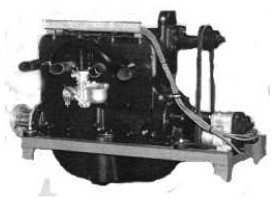
"Ford A engine"
-In the summary of the website "Power of the Past" appears the Ford model B car engine with four upright inline cylinders, water cooled, and already in the 1920's, it was adapted for use on light aircraft of the time.
-Both Ford A and B engines were widely used in planes such as Carden, Pietenpol, Air Camper, Funk, etc.

"Ford B type"
-Bernie Pietenpol was one of the enthusiasts to use the Ford engines for the aircraft he built. He used both Ford A and B engines.
-Already in 1909, another enthusiast named Charles Van Auken also adapted a Ford model T car engine on a plane of his own design.
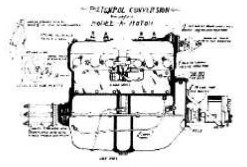
"Pietenpol modification"
-Wiley Post, a known aviator, made a conversion of this Ford A Model engine, receiving the approved Type Certificate.
-The Ford A engines were heavy with an iron casting block, and were water cooled. However, Pietenpol Kits are still built today and the purists look for original engines instead of the current ones, as they were silent and smooth to the point that at 1,800 rpm at takeoff, it seemed there was no engine.
-The Ford model B, got the ATC-715. Mounted on the Akron Aircraft Co. Interestingly enough, this engine was adapted to operate with inverted cylinders.
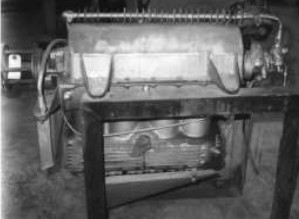
"Adapted Ford engine with inverted cylinders"
-The E Model, known as "Funk E" was adapted by the Joe and Howard Funk brothers with powers of 63 hp at 2,125 rpm and 70 hp at 2,450 rpm at takeoff.
-In 1927 appears a Ford design of a two-cylinder engine giving 36 HP hp at 2,000 rpm for the Ford Flivver. No big amounts were made.

“Ford two-cylinder”
-More recently Ford car engines have been used on experimental aircraft, such as the 5.7 ltr V-8, 351 model giving 345 hp on Marcel Jurca's 3/4 Mustang.
-Or the Javelin from Ford, 180 hp, mounted on Cessnas 172, with turbo at the top. Reduction gear by toothed belt.
-Also the Ford Falcon, and the Ford Pinto 4-cylinder with a displacement of 140 cu. in. were adapted for aviation.
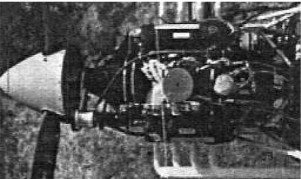
"Vista superior en Piper"
-The V-8 with a displacement of 6.5 liters has been seen in a Piper fumigation. It gave 300 hp at 4,000 rpm with a weight of 333 Kgs.
-A Ford Escort engine, prepared by Dave Blenton, was presented at the 1982 EAA exhibition. It was Installed in a Cessna 150 and an Acro Sport II.
-It is calculated that there are more than 35 Ford fiesta 1,600 cc engine conversions installed on a Piper Cub. They were also showed at the 1982 EAA exhibition..
-V8 car engines would also be modified by companies such as Arrow Aircraft and Motors Corp.


"Ford F adapted by Arrow"
-But Ford's most interesting job was that it built copies of the V-1 flying bomb engines, the German Argus engines.
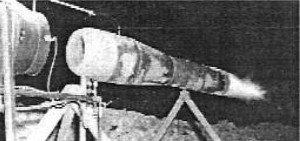
"Ford PJ31-1"
-In July 1944 the allies gathered enough German flying bombs that did not explode -despite their triple fulminating- to find out its secrets.
-The Americans copied them.
-The Republic made the cells, which were called JB-2 (Jet Bomb-2) and Ford was responsible for building the engines.
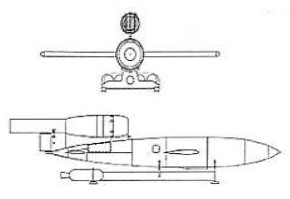
"Loon, JB-2"
-It was the "Argus-Schmidt-Rohr As109-014" and in the USA it was called PJ31-1 (from Pulse Jet). In the diagram we see the carriage propelled by rockets for launch.
-About 3000 engines were ordered, expandable to more, but the war with Japan ended earlier.
-Nearly 2,500 flying bombs had been built. The Republic called the full missile "Loon" and this was how it was known in the field of the American army.

"Loon, with Ford PJ31-1 pulsejet"
-This photograph is also taken at the NASM. The panel states that production ceased in 1950 when the Loon was replaced by the Regulus.
-It was launched with four solid fuel rockets from a platform from surface, plane or submarine as we can see in the below illustrations.
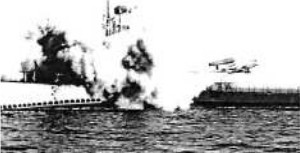
"Launching a Loon"
-It was also tested from the air, launching from the most common bomber of the USAF, the B-17. The engine of the Loon, in the case of the PJ31-F1 gave 900 Kgs of thrust.
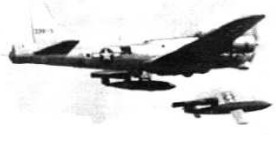
"From a B-17"
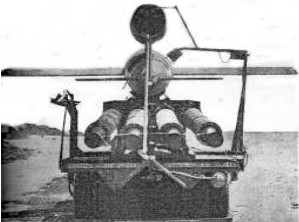
"Loon with four launch boosters"
-We finish this chapter including a curious photograph of Ford PJ-31-F-1 pulsejet tests on a P-51 Mustang.

"Ford pulsejets on a Mustang"
-Currently the Ford Motor Company is studying together with Boeing, the HALE motorization.
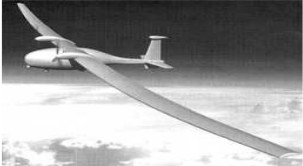
"The HALE project"
-The characteristic of the Ford engine is that it works with hydrogen capable of flying for seven days at 65,000 feet. It could be used for cartographic works, intelligence, etc.
From Appendix 6: In 2008 there was an interesting discovery in the small American town of Greenfield, in a small sugar mill located nearby, in the suburbs.
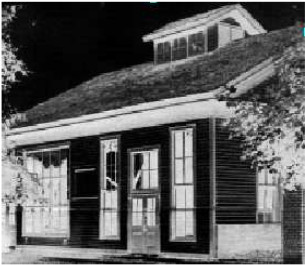
"Greenfield sugar mill"
-Despite having large glazed windows nobody gave the importance to what had been deposited there since 1955. There were about fifty engines. It seems that they came from the Ford Museum and previously from the brand's Engineering Lab.
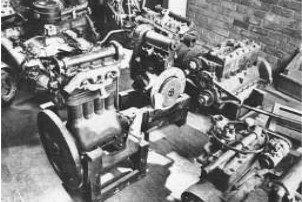
"Part of the engine lot"
-The majority are prototypes, some are unknown, and could be aviation applications as it is mentioned and for its appearance. We show some of the most significant for that use.

"Ford four-cylinder radial"
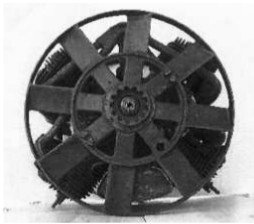
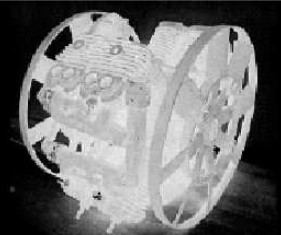
“Two views of the air-cooled X-8”
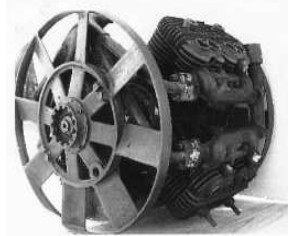
"Better view of the Ford X-8 engine fan"
-The X-8 was conceived in 1918 but the first prototype was not built until 1919 for a special car, the X-Car. There were many design changes until it was developed in 1925, the one in the photo above.
-It was tested secretly on an Oldsmobile that year. It was clearly studied for its aeronautical use, which happened with the water-cooled version.

"The water-cooled X-8 version for aviation" (PiP)
-Below we expose a new photograph of the same engine, but air-cooled.
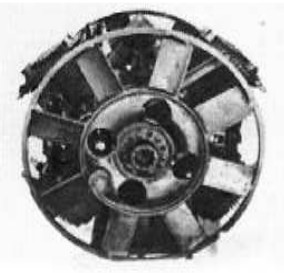
"Another X-8 version, air-cooled"
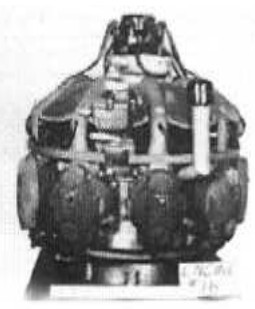
"9-cylinder radial"
-The 9-cylinder radial aviation engine was possibly intended for a helicopter. It also contemplated its terrestrial use, according to the text that accompanied the illustration.
-Next a four-cylinder boxer with L-shape chambers. It remained simply in prototype.
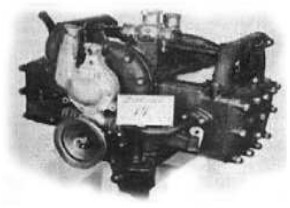
"Water-cooled boxer"
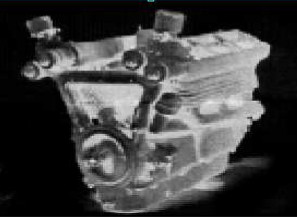
"Air-cooled V-12"(PiP)

"Ford V-8 engine"

"Ford V-10 engine"
-The V-10 with a total displacement of 309 cubic inches had the two cylinder blocks at an angle of 144°, and had a double carburetor.
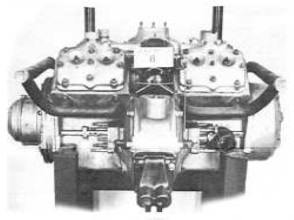
"V-8 from 1938"
-It is assumed that engines built with the block, crankcase, cylinders, etc. in aluminum had a possible aeronautical destination. The designs shown, extracted from the collection of 49 found engines, are most possible for such a use.
-Although some, those at the beginning of this chapter, clearly indicate this.
-We have received a photograph of a twelve-cylinder supercharged V-engine, made by Ford and we consider it of interest to include it, although we do not have any more data at the moment.
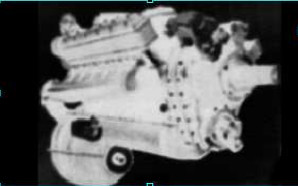
“Supercharged Ford V-12” (PiP)
-It was geared and seems to be built for aviation. A 2-cylinder V-engine was used for the tests of the V-12 and future engines that reached 1,500-1,700 hp.
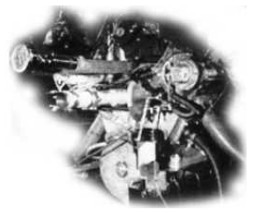
-Now another sample of the old Ford A Model engine, modified to change it to air-cooling, ignited by magneto and with long exhaust pipes. Good looking.

"Ford A Model adapted for aviation"
-Observe the wings of the cylinder heads directed almost in flight direction.
-We also have a Loon launch sequence from a submarine. We know from the main text that the engine was a Ford pulsejet, copied from the Argus V-1 engine.


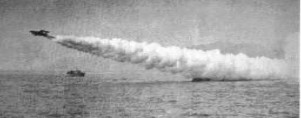
“In the third sequence the boosters are still running”
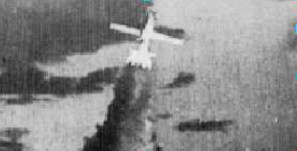
"Gaining height and speed"
-From (PiP=pm). A small three-cylinder radial engine was planned for the Ford airplane called "Tiny Flivver".
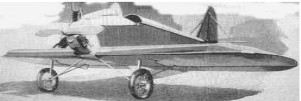
"The Ford Tiny Flivver airplane"
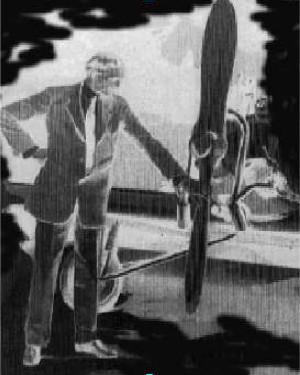
“Ford himself with his plane” (PiP)
-The most famous genuine Ford aircraft design was undoubtedly the Ford Trimotor.
-In the chapter on engines we see in previous Appendices and in the main text itself a great variety of aeronautical engines.
-But some new photographs taken by AEHS member Larry Rinek during the 2010 convention at the Smithsonian Institute, in the Udvar-Hazy section.
-This is the Ford Liberty 12A that we show below in two pictures.
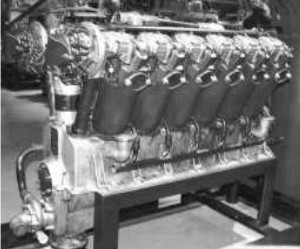
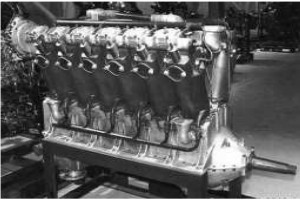
"Two photos of the Ford Liberty 12A"
-Los motores de automóvil se adaptaron convenientemente modificados como lo hizo la Arrow Aircraft Corp de Lincoln en Nebraska.
The automobile engines were adapted and properly modified as did the Arrow Aircraft Corp in Lincoln, Nebraska.
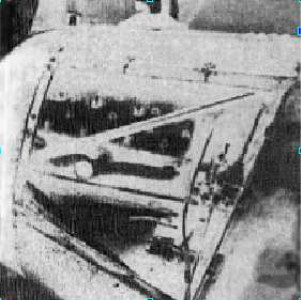
"A Ford V8 adapted for aviation" (PiP)
-On the other hand, we already know that Ford made the pulsejet engines PJ-31 for the Loon, a copy of the German V-1 engines.
-It had to be launched from a ramp powered by a battery of four Jatos. Now we have a photograph that shows us in more detail.
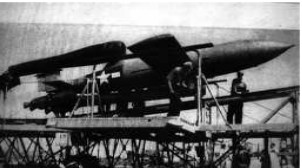
"The Loon missile after WWII"

"4 Jatos and the great PJ-31" (PiP)
-The T-Model car engine was also adapted for aviation, as we can see in the below photograph taken at the Hiller Museum in the USA.
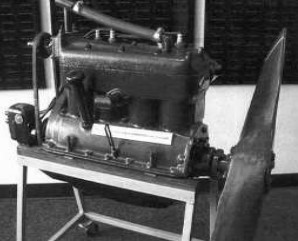
"Ford T engine adapted for aviation"
-Just as we have described in the main text, several Ford automobile engines have been taken as the basis for aerial application.
-The Geschwender one (see) was the Ford put to 330-430 hp reaching 600 hp with turbocharging.

"The Geschwender on a Funk airplane"
-In 1978, one of the small Javelin Ford engines (see) of only 180 hp was already installed in some Cessna 172, using turbocharging that, as we observe, is installed on top of the engine.
-A very wide toothed reduction belt is used to lower the engine rpm for the propeller.
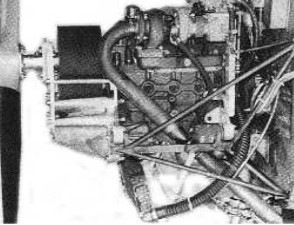
"The Ford engine modified by Javelin"
-Javelin Aircraft was situated in Wichita, in the center of the USA, in the state of Kansas. It is surprising that he used the small four-cylinder engine with 140 cu. in of displacement only. He also used the Ford Pinto and some other engine.
-Now a Ford model A engine has been located. It was used by a possible Pietenpol Air Camper, and is full of rust due to the passage of time and its abandonment.

"A Ford engine relic" (PiP)
-Observe the broken wooden propeller.
-It has important parts of the Ford V-8 engine, model 248 has become the Church but air-cooled.

"Church-Ford, V8-248 model"
-New illustration of the V-12 model engine project of Ford appeared in 1941. It had a classic aspect and it did not bring too much novelty. Like the majority, it had two exhaust valves and two intake valves, a superimposed gearbox, water pump at the front, fuel injection, etc.
-Despite the lower rear position of the supercharger -it seems rather mechanically driven by some transmission from the accessory box, rather than a turbocharger, as it actually is.
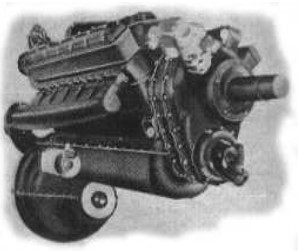
"Ford V12 scale model"
-Returning to modifications or adaption of Ford A and T engines, done successfully by Pietenpol and Corben mainly.
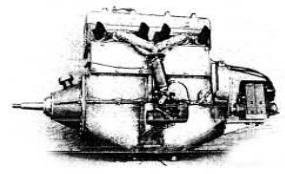
"Ford A engine, converted by Corben"
-A simple engine of the 1920's and 1930's with flat cylinder heads, and side valves. They were -and are- mounted backwards, that is, looking backwards from how they were installed in their own cars.
-In the place where the steering wheel was, they placed the propeller and in the front -now rear- exit, went the pulley for the water pump and the magneto. They gave 50 hp at about 2,000 rpm. The engine was lightened with changed pieces from ferric material to aluminum.
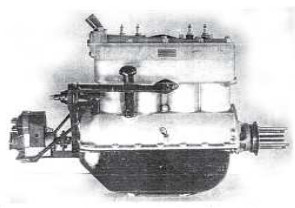
"Ford A, right side"
-In this illustration, we see the small water pump to force the circulation of cooling water to the radiator.
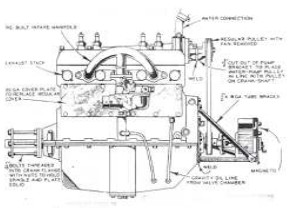
"Ford A, Pietenpol version"
-The Corben has a different intake manifold because in the vertical neck it recirculates oil to exchange heat to the mixture and to cool the oil itself at the same time.
-The Ford T shown below is the one that is exposed and photographed at the Hiller Museum and posted on the internet by "Passion-Aviation".
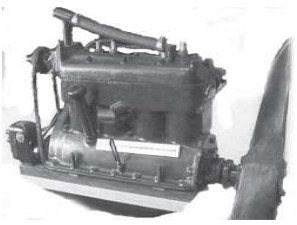
"Ford T engine converted for aviation"
-In 1941 appears a design of Ford for a V-12 engine that we now show in scale model of the time.
-It includes most castings instead of forging. It also has a powerful turbocharger working with the exhaust gases and placed in the lower part of the engine.
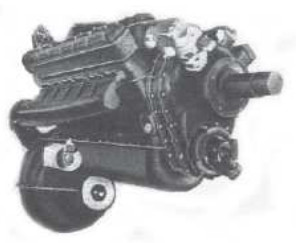
"Hitherto unheard Ford V-12"
-NOTE: this figure is repeated because it is related to the following scheme of the same engine, interesting.
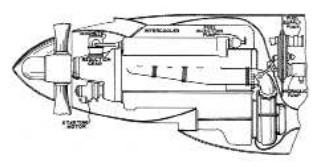
"Installation of the V-12 in its fairing"
-Continuing with the surprises of Ford in its range of new engines with unusual technology, we have an engine initially intended for automotive but clearly usable in aviation. It is not the first engine of this type with free pistons, acting as a gas generator to drive a turbine.

"Ford gas generator"
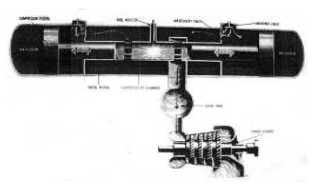
"Section of the final turbine assembly"
-Ford has been commissioned by Boeing to motorize the Phantom Eye, spy plane whose characteristic is the use of engines running on hydrogen.
-It is claimed that the residues of these engines are not toxic because it is simply water steam.
-The engines displace 2.3 liters with four cylinders giving 150 hp. The plane flies at 150-170 mph and can reach an altitude of 65,000 feet.
-We keep looking for more information.

"It shows the ability to be equipped"
-From Ford we now have a small turbine built together with Garrett, the model "Garrett-Ford AGT-101", made with ceramic materials to increase its efficiency.

"Small Garrett-Ford ceramic turbine"
-We have a picture of the Ford engine modified by Javelin.
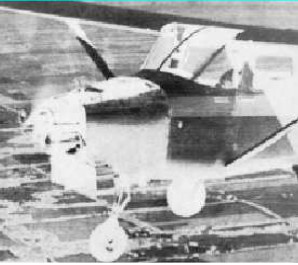
"Cessna with Ford-Javelin" (PiP)
From Appendix 9: Two Ford engines of 2.3 liters of displacement and 150 hp each are used on the pilotless spy plane, the Boeing "Phantom Eye".

"Ford 150 HP engine"
-It uses multiple turbochargers to maintain flight at about 65,000 feet.
-It can also run on hydrogen
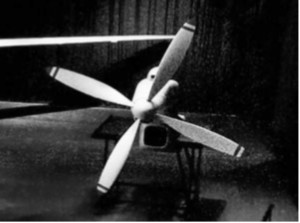
“Appearance of the Phantom Eye power group”
-The engine is geared and drives a four-blade propeller.
-The fuselage has a very voluminous body to house two spheres for fuel. At the mentioned altitude it can run for 4 consecutive days.
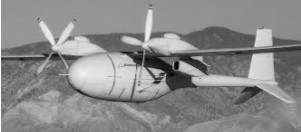
"The Boeing Phantom Eye"
-The Ford engines have been adapted to aviation, especially by Geschwender. The last known is the 460 Cobra Jet engine. See Geschwender.
Now we have found by an traceability exercise, that the Ford made the De Palma engines that were installed on airplanes guided by radio or "drones", pioneers like Kettering.
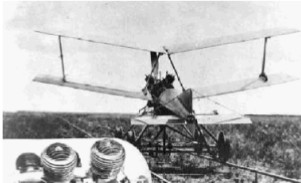
"Un par de Kettering"
-In the foreground, two cylinders of the De Palma engine
-The R model car engine was also installed at least once in 1908 and flew briefly on a "Quick" airplane in Alabama.
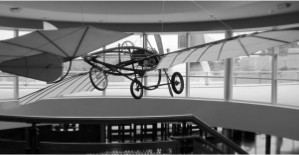
"Quick Plane with Ford R in a Museum"
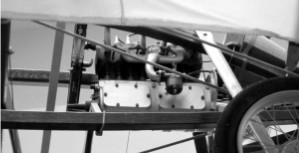
"Ford R engine in Quick plane"
From Appendix 10: Photograph of a Ford in a USA Museum. Made with Pratt and Whitney license, model R-2800-21 during WWII.

"Ford (P & W) R-2800" (Credit David Jackson)
-Two new photographs of Ford automobile engines adapted for aeronautical use.

"Four-cylinder inline Ford converted for aviation"
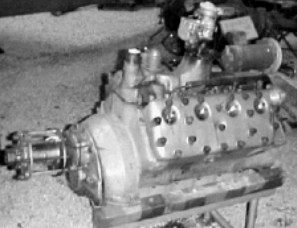
"Ford V8 with reduction gear for the propeller"
Extension to the main text chapter. A better view of the small Ford plane. With two-cylinder boxer engine.
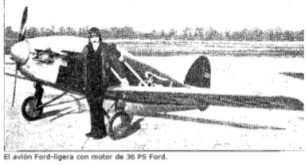
"The small Flivver with the Ford twin-flat"
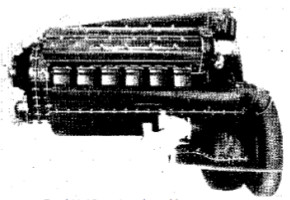
“New picture for the Ford V-12” (PiP-Flu)

“Two airplanes with Ford A engines” (PiP-Flu)
From Appendix 12: New photo of a Ford V-12 scale model with its turbocharger underneath at the rear. Maybe a bi-turbo?, one on each side for each cylinder row?

“Ford V-12 scale model”
Engines of FORD
Model: 4 cils.en X
Arquitecture: 4-cylinder X-engine
Cooling:
Total Displacement:
Bore / Stroke:
Power:
Weight:

"Four-cylinder Ford radial engine"
Model: 8 cils. en X
Arquitecture: 8-cylinder X-engine
Cooling:
Total Displacement:
Bore / Stroke:
Power:
Weight:

"Ford X-8 engine fig.3"
Model: 9 cyl. radial
Arquitecture:
Cooling:
Total Displacement:
Bore / Stroke: x
Power:
Weight:

"Ford 9-cylinder radial"
Model: AGT-101 turbine, colab. con Garrett
Arquitecture:
Compressor/s:
Combustion chambers:
Turbines:
Power / Thrust: / ---
Weight:
Model: Ford 460 Cobra Jet (Geschwender)
Arquitecture:
Compressor/s:
Combustion chambers:
Turbines:
Power / Thrust: / ---
Weight:
Model: Ford 4L varias conversiones
Arquitecture:
Cooling:
Total Displacement:
Bore / Stroke: x
Power:
Weight:
Model: Ford A, conversion
Arquitecture: 4-cylinder In-line
Cooling: Liquid
Total Displacement:
Bore / Stroke:
Power: 35 HP
Weight:

"Ford A"
Model: Ford B, conversion
Arquitecture:
Cooling:
Total Displacement:
Bore / Stroke:
Power:
Weight:

"Ford B with propeller"
Model: Ford Escort conversion
Arquitecture:
Cooling:
Total Displacement:
Bore / Stroke: x
Power:
Weight:
Model: Ford F, conversion
Arquitecture:
Cooling:
Total Displacement:
Bore / Stroke: x
Power:
Weight:

"Ford F engine adapted by Arrow fig.2"
Model: Ford Javelin, conversion
Arquitecture:
Cooling:
Total Displacement:
Bore / Stroke: x
Power:
Weight:
Model: Ford project Phantom Eye
Arquitecture:
Cooling:
Total Displacement:
Bore / Stroke: x
Power:
Weight:

"Ford, 150 HP"
Model: Ford R
Arquitecture:
Cooling:
Total Displacement:
Bore / Stroke: x
Power:
Weight:
Model: Ford T, conversion
Arquitecture:
Cooling:
Total Displacement:
Bore / Stroke: x
Power:
Weight:

"Converted Ford T engine"
Model: Ford V-10
Arquitecture:
Cooling:
Total Displacement:
Bore / Stroke: x
Power:
Weight:

"Ford V-10 engine"
Model: Ford V8’s varias conversiones
Arquitecture:
Cooling:
Total Displacement:
Bore / Stroke: x
Power:
Weight:

"Ford V-8 with gearbox"
Model: Liberty V-12A (Lic.)
Arquitecture: 12-cylinder V-Engine
Cooling:
Total Displacement:
Bore / Stroke:
Power: 400 HP
Weight:

"Ford liberty 12A fig. 2"
Model: PJ-31 en V-1 americana
Arquitecture: Rocket engine
Chambers:
Fuels:
Feed System:
Ignition:
Thrust:
Weight:

"Ford PJ31-1"
Model: Project HALE
Arquitecture:
Cooling:
Total Displacement:
Bore / Stroke: x
Power:
Weight:
Model: PW, R-2800-43 (Lic. WWII)
Arquitecture: 18-cylinder Radial
Cooling:
Total Displacement:
Bore / Stroke:
Power: 2000 HP @ rpm
Weight:

"Ford (P&W) R-2800"
Model: RR/Merlin (Lic. WWII)
Arquitecture: 12-cylinder Inverted V-engine
Cooling:
Total Displacement:
Bore / Stroke:
Power:
Weight:
Model: Twin-Flat en el pequeño Flivver A/C
Arquitecture: 2-cylinder Horizontally opposed
Cooling:
Total Displacement:
Bore / Stroke:
Power:
Weight:
Model: V-1650 (RR/Packard (Lic. WWII)
Arquitecture:
Cooling:
Total Displacement:
Bore / Stroke: x
Power:
Weight:


